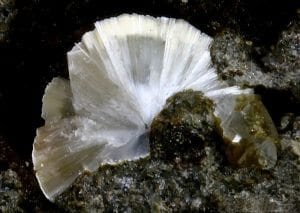Erionite-Induced Malignant Mesothelioma: Is it Different?
 Malignant pleural mesothelioma is usually thought of as an asbestos-related disease. But a growing number of mesothelioma cases are being blamed on another mineral called erionite. A new report attempts to look at the clinical and prognostic differences between mesothelioma caused by erionite and mesothelioma caused by asbestos.
Malignant pleural mesothelioma is usually thought of as an asbestos-related disease. But a growing number of mesothelioma cases are being blamed on another mineral called erionite. A new report attempts to look at the clinical and prognostic differences between mesothelioma caused by erionite and mesothelioma caused by asbestos.
Like asbestos, erionite occurs naturally in some soils and is made up of tiny, sharp fibers. Like asbestos, once these fibers enter the lungs through inhalation of dust, or the stomach through accidental ingestion, they can trigger a series of physiological changes in some people that eventually result in cancer.
The Study
In light of the rising number of erionite-induced mesothelioma cases in Europe and North America, researchers in Turkey, Ohio, and Florida designed a study to look for any key differences in the way erionite-induced pleural mesothelioma behaves and should be diagnosed and treated.
The researchers analyzed data from 33 mesothelioma studies, including 22 retrospective studies (looking back at past data), 6 prospective studies, and 5 case reports. To ensure that they were only focusing on erionite-related mesothelioma and not the much more common asbestos-induced mesothelioma, the study only included mesothelioma patients who were never exposed to asbestos. In all, 31,042 mesothelioma patients were included.
The Results
The findings on erionite-induced mesothelioma are not encouraging. According to the data, erionite may be even more toxic in the lungs than asbestos and may be more likely to cause mesothelioma in multiple family members.
“Erionite has a higher degree of carcinogenicity with possible genetic transmission of erionite susceptibility in an autosomal dominant fashion,” writes author Elamin Elamin, MD of the University of South Florida’s Critical Care Medicine and Sleep Department. The results also suggest that it does not always take a lot of erionite to trigger mesothelioma. While most cases of erionite-induced mesothelioma occurred after high levels of exposure, some cases occurred with much less.
The research team found that Chest CT was a more reliable diagnostic tool than chest X-ray and that pleural effusion, a build-up of fluid in the lungs, was the most common finding. Chemotherapy with cisplatin and mitomycin was shown to be the most common drug treatment for erionite-related mesothelioma, but the authors note that, as with asbestos mesothelioma, “cure of the disease is extremely rare.”
In parts of Turkey, where rock containing erionite was used to construct houses, there are record numbers of mesothelioma cases. Erionite has also been found in gravel used to pave thousands of miles of roads in North Dakota.
Source:
Demirer, E, “Clinical and Prognostic Features of Erionite-Induced Malignant Mesothelioma”, March 1, 2015, Yonsei Medical Journal, pp. 311-323.





